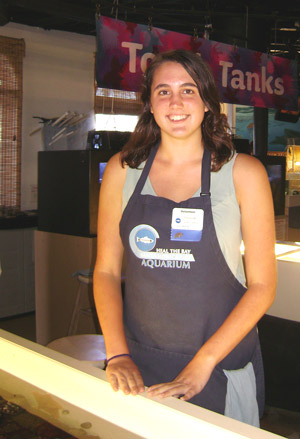Volunteering with sharks, starfish and sea slugs
Have you ever been spit on by a shark? Or seen a fish that changes gender? How about a slug the size of a cat? As a volunteer at the Santa Monica Pier Aquarium, I have the opportunity to see and talk about animals like these every day.
I started volunteering at the aquarium the summer after ninth grade. My friend Emily and I had visited it earlier in the year. We were led around the aquarium by smiley volunteers, who taught us fun facts about jellyfish and ocean tide patterns. We noticed that some of the volunteers were teens, and we thought it would be a different way to spend our summer, instead of going to academic summer programs.
The aquarium takes up one room underneath the carousel at the Santa Monica pier. There are six tanks, each with a different theme, including Rocky Reef, Moon Jellyfish and Under the Pier tanks.
Before we could start, we had to be interviewed and attend two-hour training sessions every night for two weeks. We had to learn facts about the animals so we could answer questions from visitors. The binder they gave us was intimidating: more than 60 pages of volunteer policy and scientific facts about algae, and all of the various ocean habitats (rocky shores, kelp forest, open ocean, etc.) Before we could start volunteering, we had to fill out a take-home test about all the information and watch eight PowerPoint presentations about the information in the binder, before we could start volunteering. I started to think that maybe this wouldn’t be so much fun after all.
But one of the last nights, the public programs managers Tara and Scott started to teach us stuff that was a lot more fun than what we had been learning before, because it was not just about tide, but it was specific facts about animals we had seen. For example, sea cucumbers spit out their guts when something tries to attack them. Sea stars (what people call starfish even though they’re not actually fish) have an eye on the tip of each arm, that can’t really “see” but can detect the difference between light and dark. We even learned that sea hares (a type of sea slug) are hermaphrodites, which means that they are both male and female! I thought back to my biology class in ninth grade, and if my teacher had taught us facts like these, I would have enjoyed the class a lot more.
On my first day of volunteering, I was nervous to have to deal with all of the visitors to the aquarium. I sat behind the touch tanks and tried to come up with the courage to talk to some of the kids who were looking at starfish. I wanted to say and show them things that they would find interesting. The other volunteers had taught us tips for talking with people, such as smiling and saying hello, speaking clearly, and if someone asks a question, to not just give them the answer, but to tell them more about the animals.
“Hey, have you ever touched a leather sea star?” I asked a little boy, pointing to one of the most unusual species we have in the touch tanks. The boy looked at it with wide eyes, and then ripped it off the side of the tank (definitely violating the “No Picking Up the Animals” rule). I told him politely to put it down, trying to convince him that picking them up like that tears off their tube feet, which helps them attach to the rocks. He looked at me blankly for a few seconds, put it down, and eventually walked away. I realized that the tips hadn’t helped much, but that I’d get the hang of it and get more confidence by experience.
I managed to keep up conversations with the visitors, once I learned to speak more confidently and clearly. With foreign visitors, I learned to listen slowly to what they were saying, and to use gestures to help them understand the animals. I also tried to be polite but firm when kids picked up the touch tank animals, asking them to not pick up the animals because they can get hurt (but instead touch them with two fingers). One time, a little girl followed me around the aquarium for about an hour, asking every question imaginable, most of which I could answer, which made me feel accomplished.

Starfish and sea slugs are some of Chelsea's favorite animals at the Santa Monica Pier Aquarium.Photo by Chelsea McNay, 17, L.A.C.E.S.
My favorite tank to supervise is the shark tank, not only because I know the most about the swell and horn sharks (Did you know that when horn sharks eat too many sea urchins, their horns can turn purple?) but also because I like seeing people’s reactions to the sharks. Some people cringe and stand far away from the tank, and others are fascinated, leaning up close to see their tongues and dark eyes. During feeding time on Tuesdays and Sundays, the sharks wake up and start to swim quickly around the tank, because they smell the food. The swell sharks, which get their name from their ability to swell up with water, start spitting out of the tank, occasionally hitting visitors. We say that it’s good luck if you get spit on!
When I first started volunteering, I was scared I would never be able to memorize all of the information required to teach visitors about the animals, but after a while, I found that the “fun facts” we learned were actually fun and easy to learn. I’ve spent the last 3 summers volunteering and I’ll miss it when I go off to college in the fall.










1 Comment
Wow Chelsea! It sounds like you had a lot fun. I like your story.